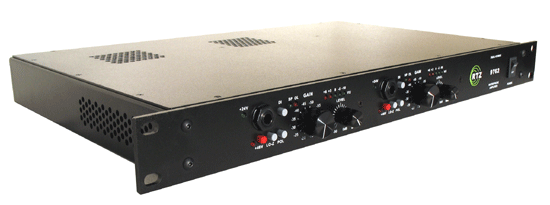
Barry's Mix Magazine Equipment And Software Reviews
Barry's Massive Discography And Engineering Career
Barry's Music Connection Magazine Reviews
Barry's Resolution Magazine Reviews
RTZ Professional Audio 9762 Dual-Combo Mic Preamp
By Barry Rudolph

The 2-channel RTZ 9762 is a single-rackspace remake of the Class-A Neve 1272 microphone preamp. The 9762 adds to the original's operation and sonics with modern features and circuit refinements. The unit's 17-pound heft and 'no frills' front panel clearly indicate that RTZ eschews functionless cosmetics for greater emphasis on value, circuit design, manufacture quality, and superior sound.
ON THE INSIDE
Both pre-amp channel boards have their own +24-volt rail voltage regulator and filtering plus independent auto-resetable thermal overload fuses with front panel indicators. Sealed Omron telecom relays with gold-clad contacts handle all audio switching.
FRONT PANEL CONTROLS
Like most Neve module conversions, there is a line amp output level control. Here a heavily damped Clarostat 308 Series pot sets final output level with the 9762 capable of a 40-volts peak-to-peak before clip. There is an internal jumper to set the line amplifier gain to either 15 or 10 dB, the factory default. Modern features NOT on a Neve and most conversions include: a Signal Present LED that lights green when a 200mV or -20dB ref .775v signal is on the input and responsive LED output VU meters for each channel with +6, +3, 0, -5, and -10dB indicators. There is also an overload LED when any clipping occurs within the input stages. When using a stock Neve module, sometimes the sound is so thick that it is hard to perceive when a short peak clips the input stage. In my use I was unable to clip the front end of the 9762 because it'll take up to 0dBu without attenuation. Finally, the 9762 simultaneously outputs audio from both an XLR balanced connector and a direct, before the output transformer, 1/4-inch unbalanced jack. Great for live sound, you can use the same pre-amp for feeding both the FOH mixer and a recording system. This is also a notable feature for home studio users with -10dBv/unbalanced systems.
Other important features are: polarity flip; +48-volt phantom powering that ramps up and down when switched on/off--no more loud pops if you accidentally leave the monitor up and engage phantom; a Lo-Z switch that (when pushed) parallels the Lundahl LL 1538 transformer's input primary windings for 50-ohms input impedance (good for old ribbon mics) or back to a nominal 200-ohms when released; Term switches a termination resistor (an internal jumper allows a choice of a 600 or 1.5-kohm resistor) across the Sowter's output winding (more later); and a 1/4-inch Hi-Z input jack for direct recording. When the DI button is pushed, a FET buffer stage bypasses the input transformer and acts as an impedance converter. With the input impedance now 10 megohm, there is no chance of loading a guitar/bass pickup or a sensitive piezo unit and changing its sound. Another pair of FETs, in conjunction with the relays, provides a wonderful output-muting feature. Not in the audio path, these are shunt switches that short the output signal to ground during any DI/Mic or impedance switching operations.
IN THE STUDIO
Switching the termination off opened up the sound of the 9762's high end for more "air" in the sound--you could hear more ambience around the singer's voice. The Neve conversion sounded nasal by comparison. Trying the RTZ's 50-ohm input impedance momentarily muted the output (nice!) and caused the level to come up. I liked the "fade up/down" phantom-powering feature--it worked perfectly. I also used the DI switch as a silent mic mute switch--if nothing is plugged into the DI input. Next up were drum overdubs. I recorded into Pro Tools|HD and used a vintage '70s API console for all of the close mics and the 9762 for overheads. With the termination off, I found the overhead mics (wide-spaced B&K/DPA 4011 cardioids about 1 meter above the toms) to sound more open than the stock API channels. I could hear more of the whole kit and the room, and there was loads of gain. I used 20 dB of gain with the output level set to about 3 o'clock. The DI input worked well for a Fender P-Bass with passive pickups. This path is just like a very expensive FET DI box you would need to add to any Neve unit. Again resulting in better subsonics, I attribute that to the better-quality transformers in the 9762 than a Neve. The 9762 is very quiet--especially noticeable when following the pre-amp with a compressor.
PROMISES KEPT
RTZ Professional Audio at www.rtzaudio.com. |
|
|
|
All Web Page Design Is Copyright © 2006 through By Barry Rudolph